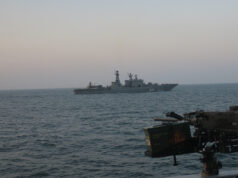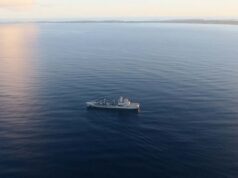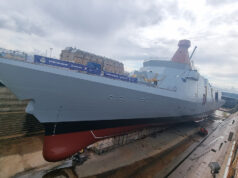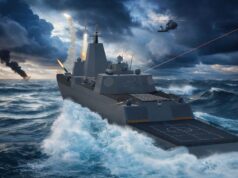The Ministry of Defence has issued a Request for Information (RFI) inviting industry to participate in Atlantic Thunder 26, a major US–UK live-fire exercise planned for May 2026 at the QinetiQ Hebrides range in northwest Scotland.
The exercise will culminate in a SINKEX, or sinking exercise, involving British and American naval and air forces striking a target ship.
A SINKEX is a live-fire drill in which naval and air forces engage a decommissioned vessel with real munitions to test weapons systems and tactics under operational conditions. In the context of Atlantic Thunder 26, the Ministry of Defence describes it as a joint US-UK exercise “designed to validate SUW kill chains, build resilient kill webs and deliver strategic messaging through kinetic demonstration” off the Hebrides in May 2026.
Once struck and sunk, the hulk will settle at a depth of around 6,000 feet, where uncrewed underwater vehicles will be used to conduct battle damage assessment and seabed surveys, providing both a test of new technology and a practical demonstration of interoperability.
In 2022, the Royal Navy and US Navy carried out Atlantic Thunder 22, a rare live-fire trial off the Hebrides that culminated in the sinking of the decommissioned frigate USS Boone. The exercise brought together HMS Diamond, USS Arleigh Burke, RAF Typhoon jets and US Navy P-8 Poseidons in a coordinated strike that saw multiple weapons delivered against the target.
It was billed at the time as the most complex multinational SINKEX ever staged in UK waters, providing both a demonstration of allied firepower and critical data on how British and American forces integrate ‘kill chains’ in real-world conditions.
According to the RFI, “AT26 is a US–UK multi-domain exercise designed to validate SUW kill chains, build resilient kill webs and deliver strategic messaging through kinetic demonstration that will take place off the coast of the Hebrides in Scotland from 11th–22nd May 2026.”
The Royal Navy’s Develop Directorate is seeking outline proposals by 12 September 2025, with an internal board scheduled for mid-September to decide which industry participants will receive national sponsorship. Successful companies would then be integrated into the planning cycle for the operational experimentation (OpE) phase.
The RFI makes clear that the exercise will not be a showcase event but a developmental environment to address capability shortfalls. “Whilst AT26 presents opportunities to showcase technology, and for Industry contributions to be highlighted during the exercise to an appropriate audience, it must be understood that this is a development exercise. The focus will be on accelerating capability delivery by addressing the capability blockers listed,” the document states.
Particular interest is placed on uncrewed underwater vehicles (UUVs) able to perform underwater battle damage assessment after the strike. Areas flagged for demonstration include high-resolution scanning at depths down to 6,000 feet, autonomous and AI-driven mission tools, long-endurance and low-signature platforms, and new approaches to launch and recovery. The RFI also calls for novel communication systems for bandwidth-constrained environments and “solutions to support ‘system to system’ integration including across security domains.”
The ministry stresses that all proposed systems must be fully operational at the start of the exercise and integrated into its command-and-control architecture. UK sponsorship will require industry partners to commit to a series of remote planning meetings and in-person conferences, with contribution to this “drumbeat” of activity a condition of participation.
The ministry sets out seven intended outcomes, including developing its understanding of emerging technologies, aligning requirements with industry standards, and enabling the design of a future procurement strategy. The RFI also seeks to “accelerate national and bilateral Maritime Uncrewed Systems development programmes… drive interoperability and interchangeability in MUS… and promote the operational exploitation of MUS capabilities to fulfil the maritime capability gaps.”














I hope it’s not one of the decommissioned T23s.
Might be too rotten to give the required data.
It’s harsh but they’re not doing anything else useful, better than sending them to a scrapyard in turkey.
100%! if there is NO sell-on option, NO more operational life, NO museum destination, and can be made environmentally safe, it should be SINKEX every time. Granted, not nice to see for those that served onboard. Last act of a loyal ship for it’s country.
Mmm could this herald the U.K. actually testing an NSM, call me old fashioned but it’s nice to know that they work 🤷🏼♂️
Agree, will be really interesting to see what such an advanced missile can do to a large target, hopefully they use something decent as the target.
Needs to be quite large, MILSPEC and a hull that isn’t rotten!
It also needs to be decontaminatable.
That narrows the field.
There’s a couple of near useless Scottish ferries that would be ideal candidates.
Should have had Cats.
Well at least it won’t be the economy they’ll sink , Rachel from accounts has done that already.
*A T26*
Bloody hell, they aren’t even finished yet. Could we not just use Bulldozers again ?
AT26 =Atlantic Thunder 2026, just incase anyone didn’t get the joke.
Yes, It’s always better to explain this alien concept.
Mind you if you have to explain a joke it’s not really much of a joke….boom, boom.
Seems logical.
These are rare, and worth their weight in gold.
I wonder what damage an Albion can take.
What if they couldn’t sink it? That would be serious egg on face. lol.
Torrey Canyon. !
Showing yer age mate!
178 and 3/4’s but a mental age of 7.
lol I beat you by a month on mental age. First operational use of napalm by the RAF that too, best Buccaneer flying I ever saw.
Look up the SINKEX of ex-USS America. The Yanks threw everything at it and it wouldn’t sink! But then, they are supposed to be designed to survive battle damage. When Boxer and Brave were used in a SINKEX in 2004, Boxer was apparently locked down to ‘Zulu’ to see how long a frigate really could survive. The Type 23, Argyll maybe?, just about emptied her magazines turning her into a virtual pepper-pot before she would sink. Quite reassuring really.
Way to much is being shown on media, military upgrades and tests need to stay under lock and key!!. If this drill fails then other countries will see, to much vital intell has been shown to the world as is
Well if I ever get charged with assault I know what my defence will be. 😂
“Sorry Your Honour I was simply trying to deliver strategic messaging through kinetic demonstration.”
Ahh, well in that case,
The Judge will *Throw the book at you*.
I don’t charge for this material guys.
It would be nice if they could sink in a depth that would be reachable by sport divers, make it something of interest and an artificial reef that people could enjoy.
It’s a pity they don’t sink them at diveable depths. The wrecks around the coast are deteriorating rapidly.
Do they automate these vessels in any way to make them moving targets?
Seems like a relatively easy win to create a more demanding and realistic scenario.